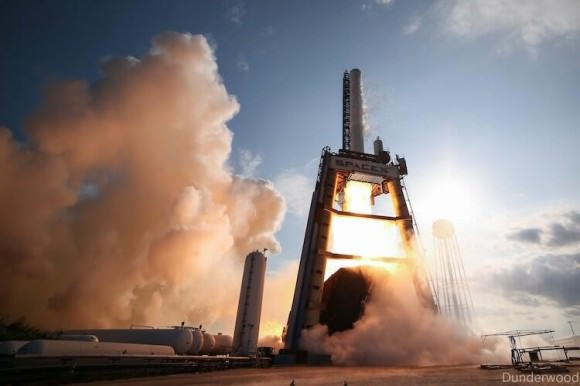Did you take a moment to look at that August video of the Grasshopper rocket deliberately going sideways and then appearing to hover for a bit before returning to Earth? For more video fodder, there’s also this high-flying test the rocket took in October.
We hope you enjoyed these views, because Grasshopper is being retired. SpaceX now wants to focus its energy and resources on to the larger Falcon 9-R first stage, which should see its first test flight in New Mexico this December.
It sounds like SpaceX would have loved to go further, in a sense. “In some ways we’ve kind of failed on the Grasshopper program because we haven’t pushed it to its limit,” SpaceX president Gwynne Shotwell said at the International Symposium for Personal and Commercial Spaceflight (ISPCS) in New Mexico last week, as reported in the NewSpace Journal. “We haven’t broken it.”
Grasshopper took eight test flights during its flight history, which spanned about a year between September 2012 and October 2013. It was intended to test Vertical Takeoff Vertical Landing technology (VTVL). The strange appearance of a rocket leaving Earth and gently, deliberately touching back down again turned heads — even in the general public.
We have coverage — and videos! — of most of its past test flights here (the dates below are flight dates, not publication dates)
- November 1, 2012: Flight to 106 feet (32 meters).
- December 17, 2012: Flight to 131 feet (40 meters).
- March 7, 2013: Flight to 262.8 feet (80.1 meters).
- April 17, 2013: Flight to 820 feet (250 meters).
- August 13, 2013: Divert maneuver!
- October 13, 2013: Highest test flight yet (2,440 feet or 744 meters).
Most rockets are single-use only and are discarded either in orbit or (better yet, for space debris concerns) are put in a path to burn up in Earth’s atmosphere. SpaceX, however, wants its next-generation Falcon 9 rocket to have a reusable first stage to cut down on launch costs. (Grasshopper was about 10 storeys high, while the Falcon 9 will be about 14 storeys tall when carrying a Dragon spacecraft on board.)

As for the Falcon 9 series, a rocket flight in September delivered its payload (which included the Canadian Cassiope satellite) to space successfully, but faced some technical problems with the upper stage — and the first stage, as the rocket was supposed to be slowed down for splashdown.
As Space News reported, two burns were planned. The first worked, but the second burn took place while the rocket was spinning, which affected the flow of fuel. A picture shown by SpaceX demonstrated the rocket was intact three meters above the ocean, although it did not survive after it hit.
“Between the flights we’ve been doing with Grasshopper and this demonstration that we brought that stage back, we’re really close to full and rapid reuse of stages,” Shotwell said in the report.


Looks like they are getting closer and closer to actually landing a stage 1 instead of just having it splash down. A good step forward in my opinion.